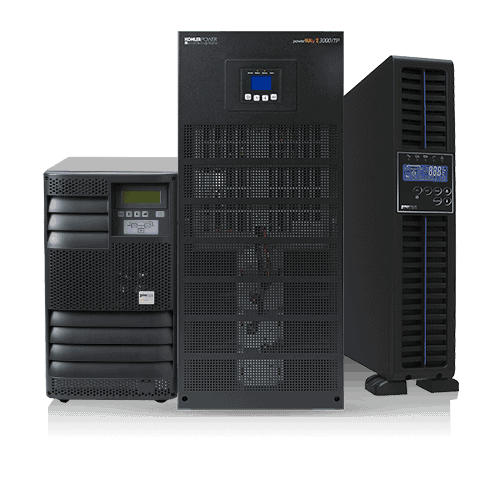When selecting a UPS system for your installation, you want it to be suitable in every respect for the site it has to supply. The UPS suitability is judged firstly by its power rating and scalability, but also by its ability to handle other aspects of loads that can potentially appear in most if not all sites. Below are the major points to consider while specifying a UPS system for your facility.
Key power supply parameters
A good starting place is to gather key points about your site’s load, as listed below.
- Supply voltage
- Supply frequency
- Number of phases
- Load current
- Power factor
- Power consumption
Load variations and site surveys
Most items of IT equipment have labels with information concerning their electrical characteristics. Collating this information will provide a reasonable indication of load power requirements, but will not give an accurate view of load variation over time. The only reliable way of determining this ‘load profile’ is to perform a site survey, or ask your UPS supplier to do so for you.
This usually involves installing portable measuring and monitoring equipment to record the load and its variations over a period of time. In scheduling this temporary installation, it’s essential to ensure that it truly reflects load use over time – it would be misleading, for example, to monitor an office network during evenings or over a weekend when very few staff will be on site and using their machines.
Single-phase and three-phase UPSs
Three-phase UPS systems can be used to power both three-phase and single-phase loads, however, a single-phase UPS systems can only supply single-phase loads. Note that single-phase loads should be balanced, or distributed as evenly as possible, between the phases of a three-phase UPS. This allows the capacity of the UPS system to be fully utilised, and presents a balanced load to the mains supply or backup generator if installed, whenever the UPS is bypassed.
Power consumption and power factor
Power consumption may be stated in Watts (W) or Volt-Amperes (VA) but rarely both. Alternatively, a load’s VA rating can be found by multiplying its specified voltage by its current rating. Then, multiplying this VA value by the load’s power factor will yield its power consumption in Watts.
Traditionally, loads have tended to present a lagging, inductive power factor to the UPS system. However, the advent of switch-mode power supplies (SMPSs) within equipment such as blade servers has shifted the power factor to near unity, and sometimes to a leading (capacitive) value. It is important to ensure that the UPS can handle leading power factor loads without derating and to check that a large SMPS load does not severely increase harmonic content.
Problem loads
Although UPS systems are generally resilient, there are certain types of load that require special consideration when connecting to a UPS. These include:
- Blade servers
- Fluorescent gas discharge lighting
- Motors and compressors
- Air conditioning equipment
- Laser printers
- Dimmable lighting systems
These items can draw high or pulsed currents during normal operation or start-up, possibly overloading the UPS system or causing unintended operation. Intermittent alarms or unwanted transfers between inverter and bypass mode may occur during start-up, for example.
Other factors
The UPS Handbook, written by and available from KOHLER Uninterruptible Power Ltd., covers the above topics in more detail, especially with regard to neutral, inrush and harmonic currents. It also addresses related UPS installation issues, including site capacity, UPS topology and load protection priorities. Contact us to organise a Site Survey for your business by calling us on 0800 731 3269 or email [email protected].




